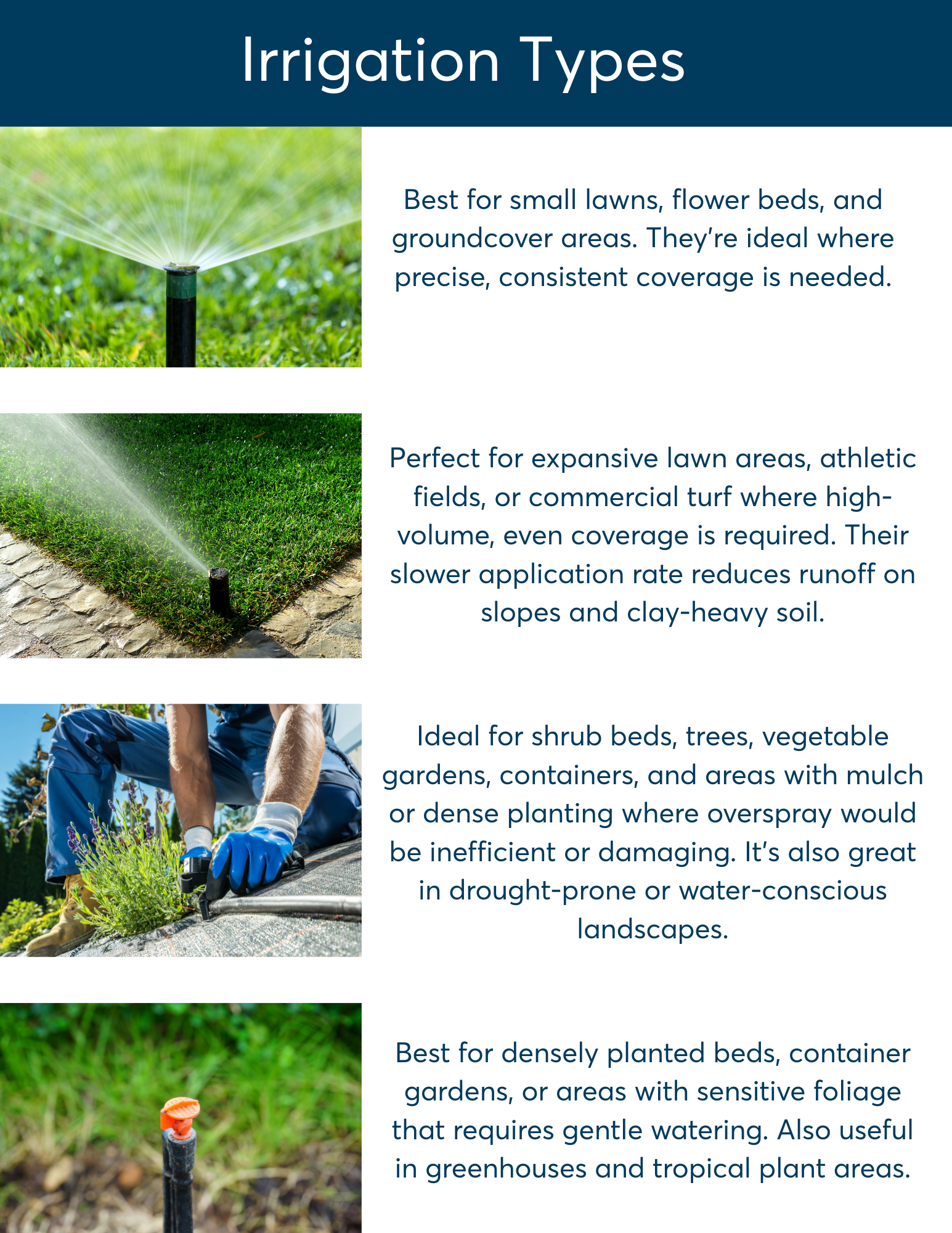Proper irrigation is essential to maintaining a healthy, efficient landscape in North Carolina’s climate. However, not all irrigation heads serve the same purpose. Understanding the differences between fixed spray, rotor, drip, and mist irrigation systems and selecting the right one for your landscape’s needs can mean the difference between lush, thriving plantings and costly water waste.
Here’s a breakdown of each type and how it should be used effectively:
Fixed Spray Heads
What They Are:
Fixed spray heads distribute water in a fan-shaped pattern and are typically used for smaller, even-shaped areas. They deliver water quickly, covering short distances—generally 5 to 15 feet.
Where to Use Them:
Best for small lawns, flower beds, and groundcover areas. They’re ideal where precise, consistent coverage is needed.
Runtime in NC:
Due to their high precipitation rate (1.5–2 inches per hour), they only need to run for 10–15 minutes per zone, depending on soil type and slope. Water early in the morning to reduce evaporation and avoid fungal issues.
Rotors
What They Are:
Rotor heads rotate as they spray, covering a much larger radius—typically 15 to 50 feet. They apply water more slowly than fixed sprays, making them ideal for larger areas.
Where to Use Them:
Perfect for expansive lawn areas, athletic fields, or commercial turf where high-volume, even coverage is required. Their slower application rate reduces runoff on slopes and clay-heavy soil.
Runtime in NC:
Because they apply water at a slower rate (around 0.5 inches per hour), they typically need 30–40 minutes per zone. Again, early morning watering is best to reduce disease risk and water waste.
Drip Irrigation
What It Is:
Drip irrigation delivers water slowly and directly to the base of plants through a network of tubing and emitters. This system greatly reduces evaporation and runoff.
Where to Use It:
Ideal for shrub beds, trees, vegetable gardens, containers, and areas with mulch or dense planting where overspray would be inefficient or damaging. It’s also great in drought-prone or water-conscious landscapes.
Runtime in NC:
Run times vary by emitter type and flow rate, but typically 30–60 minutes, 2–3 times per week. Monitoring soil moisture is key to avoiding overwatering.
Misting or Micro-Spray Heads
What They Are:
Micro-spray or misting heads emit a fine mist or light spray in a small radius. They are often adjustable and used for delicate areas.
Where to Use Them:
Best for densely planted beds, container gardens, or areas with sensitive foliage that requires gentle watering. Also useful in greenhouses and tropical plant areas.
Runtime in NC:
Because misting heads apply water lightly, they generally need to run for 20–30 minutes, depending on plant needs and ambient humidity.
Choosing the Right Head for the Right Area
Matching irrigation type to plant and soil needs ensures healthy growth and water efficiency. Using rotor heads on a small bed would waste water; using fixed spray heads on a large lawn leads to uneven coverage. Combining types—while keeping zones separate—is common in well-designed systems.
Proper scheduling and seasonal adjustment are critical. In North Carolina, irrigation should generally run early in the morning, 2–3 times per week during summer months. Always adjust for rainfall, and consider smart controllers for automated weather-based changes.
